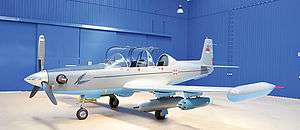UTVA Kobac
| Kobac | |
|---|---|
 | |
| A mock-up of the "Kobac" | |
| Role | Attack/Military trainer/Counter-insurgency aircraft |
| Manufacturer | Utva Aviation Industry |
| Designer | Military Technical Institute Belgrade |
| Status | In development |
| Primary user | Serbian Air Force |
| Number built | 1 prototype |
|
| |
The UTVA Kobac is a prototype light military trainer aircraft in development by UTVA. It is a single-engine, low-wing tandem-seat turboprop training aircraft with a metal airframe. The aircraft will be capable of higher basic training functions including aerobatics, instrument, tactical flying and it provides an easy transition to jet trainer at higher training levels. And also will be capable of performing close air support, counter insurgency (COIN), and reconnaissance missions. Kobac is Serbian for sparrowhawk.
Development
The Kobac will represent a level above the Lasta 95 in basic pilots training. In flight, the Kobac is projected to have a top speed of 310 miles per hour. Although the Kobac is based on the Lasta airframe, there are numerous modifications to suit its new roles. The most obvious is the 750-shp turboprop engine in a lengthened nose. Two engine options will be offered in the production version. The 750 shp Pratt & Whitney Canada PT6A-25C or the 730 shp Ivchenko-Progress AI-450C-2. The rear fuselage is lengthened and a new fin has been designed to handle the increased power. Tip tanks add 420 pounds of fuel to the internal load of 344 pounds, raising endurance to approximately five hours.
While the Lasta-95 has basic armament capability for weapons training, with two hardpoints for gun pods or light bombs, the Kobac is designed for full combat operations. It has five hardpoints for the carriage of more than 1,100 pounds of stores. All four underwing pylons can carry freefall bombs, seven- or sixteen-tube rocket launchers and gun pods for 0.5-inch or 20-mm weapons. The outer wing pylons can mount air-to-air or air-to-surface missiles, or racks for practice bombs. The centerline hardpoint can carry an electronic warfare pod.
UTVA has redesigned the Kobac’s cockpit area with a new canopy offering better visibility than the Lasta-95. It has been designed ergonomically to be fully compatible with 90 percent of the pilot population and safe-compatible with 99 percent. The rear seat is raised by approximately four inches to give the back-seater good forward vision. Both positions are fitted with Martin-Baker Mk 15B lightweight ejection seats. A modern three-screen cockpit is installed, with a large central multifunction display for tactical displays and sensor imagery. Control of the system is by HOTAS (hands-on throttle and stick). A navigation and attack system has been devised with sensors mounted in a low-profile pallet under the center fuselage. [1] Its development was revealed to the public on April 2, 2012 by Serbian Minister of Defense Dragan Šutanovac. The first prototype flight is planned for 2013.[2]
Specifications (Kobac prototype)
General characteristics
- Crew: Two, student and instructor
- Empty weight: 1,325 kg (2,921 lb)
- Gross weight: 1,700 kg (3,748 lb)
- Powerplant: 1 × Pratt & Whitney Canada PT6A-62 turboprop, 857 kW (1,149 hp)flat-rated at 708 kW (950 shp)
Performance
- Maximum speed: 555 km/h (345 mph; 300 kn)
- Cruising speed: 500 km/h (311 mph; 270 kn) at 7,620 m (25,000 ft)
- Stall speed: 143 km/h (89 mph; 77 kn) EAS flaps and gear up, 128 km/h (80 mph; 69 kn) flaps and gear down
- Range: 1,537 km (955 mi; 830 nmi)
- Service ceiling: 11,580 m (37,992 ft)
- g limits: + 6.0 g to -3.0 g
- Rate of climb: 20.8 m/s (4,090 ft/min)
- Take-off distance over 50 ft (15 m) obstacle at sea level: 1,280 ft (296 m)
- Landing distance over 50 ft (15 m) obstacle at sea level: 2,295 ft (510 m)
Video promotion
See also
- Aircraft of comparable role, configuration and era
- KAI KT-1
- PZL-130 Orlik
- Pilatus PC-9
- Embraer EMB 314 Super Tucano
- Embraer EMB 312 Tucano
- Short Tucano
- Texan II
- TAI Hürkuş